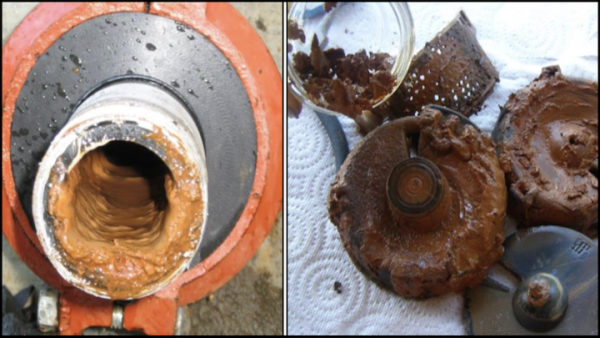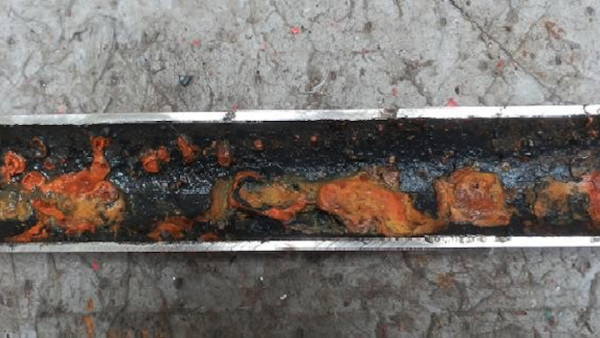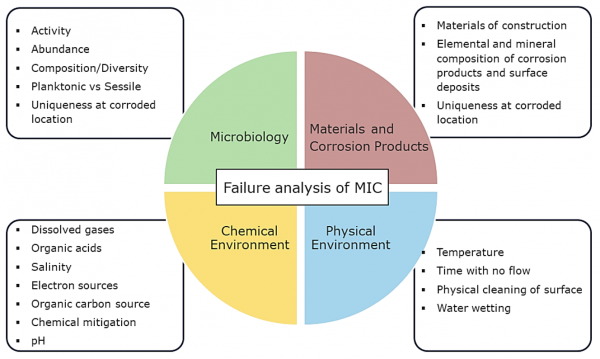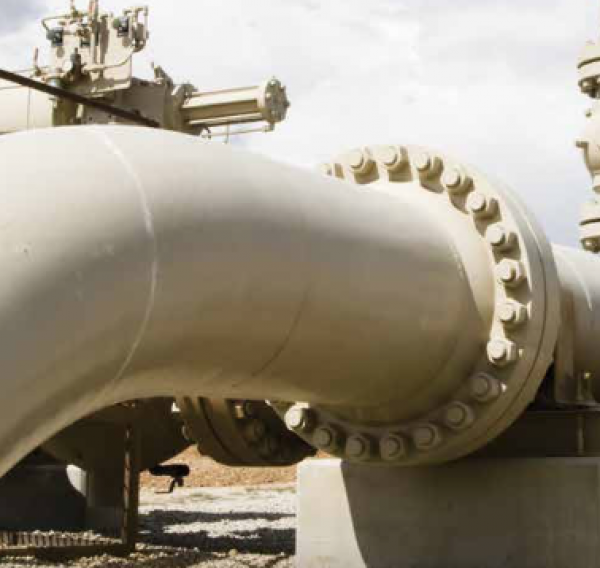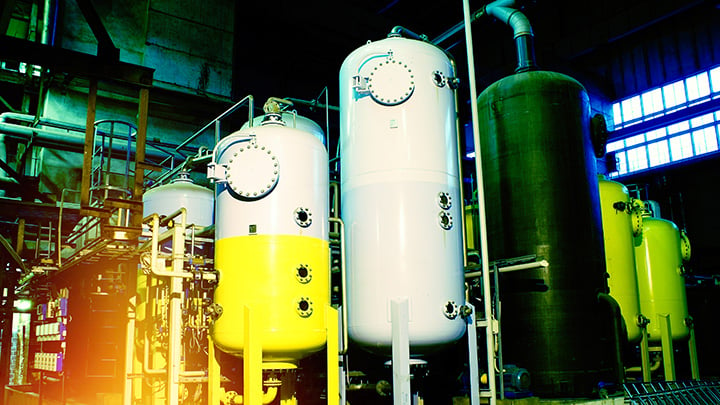Microbiologically Influenced Corrosion (MIC), also known as microbial-induced corrosion, is a type of corrosion that occurs when microorganisms, such as bacteria, algae, or fungi, influence and accelerate the development of corrosion on metals. MIC is a complex and often insidious form of corrosion that can lead to significant damage in various industrial and environmental settings. MIC occurs when microorganisms proliferate on metal surfaces exposed to water (fresh or seawater), crude oil, hydrocarbon fuels, process chemicals, and/or soil. These microorganisms form biofilms, which provide a favorable environment for microbial growth and serve as a barrier against conventional corrosion inhibitors.
Microbiologically Influenced Corrosion can be a direct result of microorganisms producing metabolites that are corrosive to metals or facilitate the formation of corrosive species. For example, sulfate-reducing bacteria produce hydrogen sulfide (H2S), which can cause sulfide stress corrosion cracking in pipelines. MIC can also be an indirect result of microorganisms altering the local environment, leading to changes in pH, oxygen concentration, or the formation of concentration cells that promote localized corrosion.
Microbiologically Influenced Corrosion can result in localized corrosion and pitting, which can lead to metal thinning, perforation, and structural damage. The rate and severity of MIC are influenced by environmental factors like temperature, pH, salinity, oxygen concentration, and the availability of nutrients, as well as the composition, microstructure, and electrochemical properties of the metal surface. Understanding these factors is critical for implementing effective inspection/mitigation strategies.
Areas Susceptible to MIC
Microbiologically Influenced Corrosion affects a variety of industries and equipment types. In the Oil and Gas industry, MIC is commonly observed in pipelines, especially those carrying crude oil or natural gas with high sulfur content. Pipelines and piping systems that transport produced water, which often contains microorganisms, are also susceptible to MIC. Additionally, MIC can affect pumps, valves, storage tanks, and heat exchangers. Cooling systems, particularly those utilizing open-loop cooling towers, are also susceptible to MIC. Microorganisms in the cooling water, along with heat and nutrient availability, create an ideal environment for biofilm formation and subsequent corrosion. Offshore structures such as platforms, risers, and subsea pipelines are also at high risk for MIC because of the presence of marine biofilms.
MIC Inspection
Accurate and timely detection of Microbiologically Influenced Corrosion is essential for implementing effective mitigation measures. Here are some inspection techniques commonly used to identify MIC:
- Visual Inspection: Regular visual inspections are valuable for identifying visual indicators of MIC, such as biofilm formation, localized corrosion, pitting, or discoloration on the metal surface. This method is particularly useful for detecting early signs of MIC in accessible areas.
- Non-Destructive Evaluation (NDE) Methods: NDE techniques allow for the assessment of metal integrity without causing damage. Ultrasonic testing, magnetic particle inspection, and radiographic examination can identify signs of corrosion, including pitting, cracking, and wall thinning caused by MIC.
- Microbiological Testing: Microbiological analysis involves collecting samples from the metal surface, biofilms, or the surrounding environment and analyzing them for the presence and abundance of corrosive microorganisms. This can be done through techniques such as culture-based methods, DNA sequencing, and molecular assays.
- Corrosion Rate Measurements: Monitoring corrosion rates helps identify areas experiencing accelerated corrosion due to MIC. Techniques such as weight loss coupons, corrosion probes, and electrochemical methods like linear polarization resistance and electrochemical impedance spectroscopy provide quantitative data on corrosion rates.
MIC Mitigation/Prevention
Once Microbiologically Influenced Corrosion is detected, appropriate mitigation strategies should be implemented to minimize its impact. These strategies include:
- Material Selection: Choosing corrosion-resistant materials, such as stainless steels or alloys with enhanced resistance to MIC, can significantly reduce susceptibility to corrosion.
- Cathodic Protection: Applying cathodic protection systems, like sacrificial anodes or impressed current systems can reduce the potential for corrosion.
- Biocide Treatment: Applying biocides to control microbial growth can be effective in preventing or reducing biofilm formation and the subsequent corrosion caused by MIC. However, careful consideration should be given to environmental and safety aspects when using biocides.
- Corrosion Inhibitors: Tailoring corrosion inhibitors specifically designed to combat MIC can provide a protective barrier on metal surfaces, inhibiting the corrosive effects of microorganisms.
- Environmental Monitoring and Control: Adjusting environmental conditions, such as controlling pH, temperature, and oxygen levels, can help create an unfavorable environment for microorganisms and inhibit the development of corrosion.
Related Topics
- Brittle Fracture
- Carburization
- Cavitation
- CO2 Corrosion
- Cooling Water Corrosion
- Corrosion Fatigue
- Corrosion Under Insulation (CUI)
- Cracking
- Decarburization
- Embrittlement
- Erosion Corrosion
- Fatigue (Material)
- Flue Gas Dew Point Corrosion
- Graphitization
- Green Rot
- High Temperature Hydrogen Attack (HTHA)
- High-Temperature Creep
- Hydrochloric (HCl) Acid Corrosion
- Hydrofluoric (HF) Acid Corrosion
- Hydrogen Embrittlement
- Hydrogen Stress Cracking
- Liquid Metal Embrittlement (LME)
- Metal Dusting
- Naphthenic Acid Corrosion (NAC)
- Phosphoric Acid Corrosion
- Pitting Corrosion
- Spheroidization (Softening)
- Stress Assisted Corrosion
- Sulfidation Corrosion
- Sulfuric Acid Corrosion
- Thermal Fatigue
- Vibration-Induced Fatigue
- Wet H2S Damage
Relevant Links
Topic Tools
Share this Topic
Contribute to Definition
We welcome updates to this Integripedia definition from the Inspectioneering community. Click the link below to submit any recommended changes for Inspectioneering's team of editors to review.
Contribute to Definition


